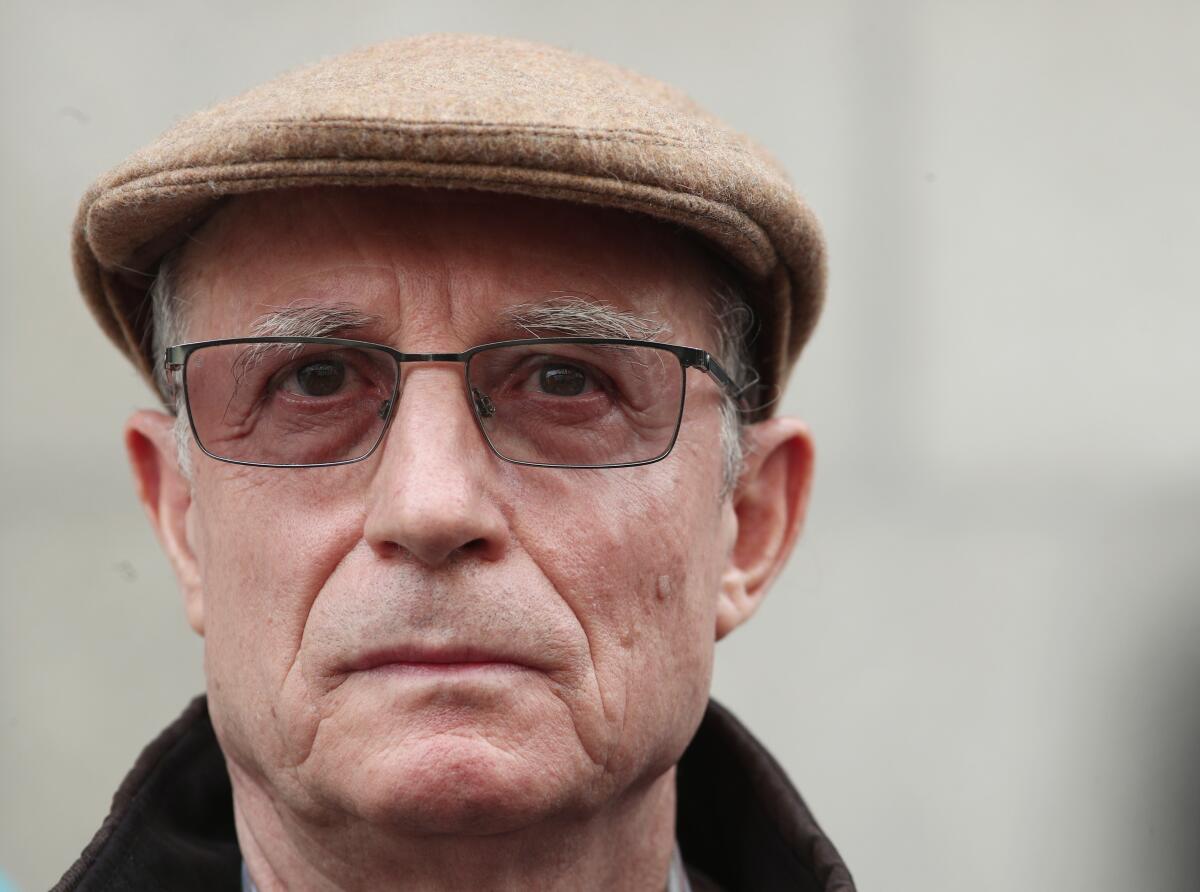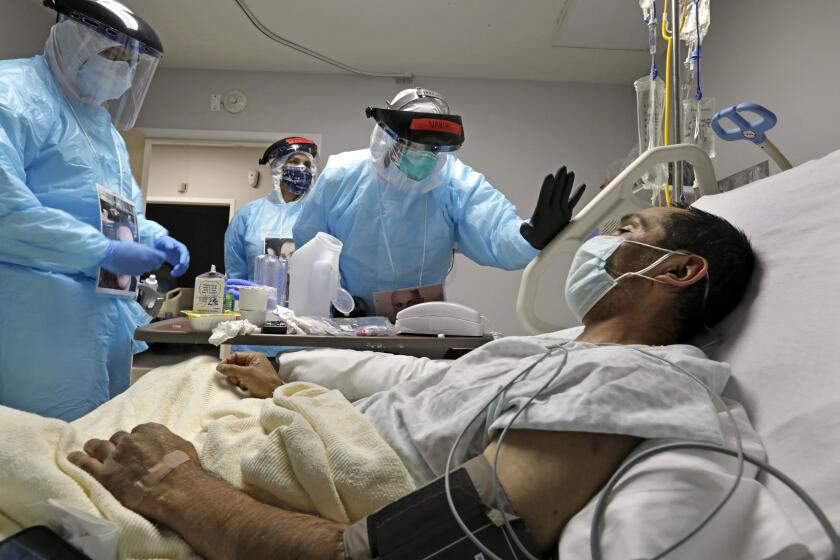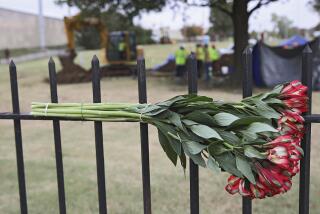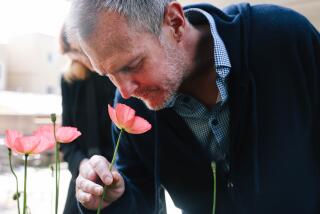Column One: Years ago, he saved her. Then one day he helped his wife kill herself

“Are you sure you want to die?”
Ángel Hernández stared at his wife through clear glasses. His face was pallid, haggard, his lip quivering.
María José Carrasco, 61, and eight years his junior, drooped in a squeaky red armchair. Her body was limp, her face sunken, and her mouth sagged into a scowl. But Carrasco wasn’t angry; she was nervous, uneasy even. Uneasy and in pain. She had endured multiple sclerosis for 30 years, and it was ravaging her body.
“Would you like it if we do it tomorrow?” Hernández said, glancing into the camera recording it all.
“Yes.”
“OK,” he sighed. “Well, I suppose there’s nothing more to be said.”
“No,” she responded. “The sooner, the better.”
Silence followed the recording. Part of Hernández couldn’t quite believe what was happening. This was something he had suppressed, considered, accepted and then suppressed again. Back and forth, a wearisome rally in his head, for three decades.
Hernández knew that what he was about to do probably meant prison. He knew that his face would appear in every one of his country’s newspapers. He would become a momentary lament over breakfast or a boozy debate at a bar. And while some would support him, some would rather see him burn in hell.
There was a time when Hernández tried to show Carrasco that life was worth living. But as years passed, he began to question everything he had thought was kindness, everything he thought was generous.
Was he trying to keep her alive for her sake? Or for his? Was he selfish?
Carrasco had her own fears, not of death but of what her husband would face after her suicide. Prison? Would he become a pariah? They had never had children because they did not want someone between them. They were for each other. But soon she would be gone, and he would be alone.
That afternoon, on April 2, 2019, as Hernández peered into his wife’s sunken eyes in the couple’s cramped living room on the outskirts of Madrid, he was still torn. Everything was about to end, and everything was about to begin. He would end her suffering, but he would also open up an abysmal absence.
But personal concerns had to cede to higher objectives. After all, Hernández and Carrasco had planned it this way. For months, they had given press interviews and shot videos showing Carrasco’s day-to-day life. “Videos that were designed to show María José’s suffering,” Hernández lawyer would later tell the press.
The reality was this: The next day, Hernández would wake up and help his wife die. And then, he would have to be alone.
::
Hernández came from a poor family in Madrid’s Alcala de Henares suburb — his father was a factory worker, his mother a homemaker. He was rebellious and had spent the years in prison during Francisco Franco’s dictatorship. The charge was terrorism, though the action was breaking windows at a bank. He denies it. “I wasn’t even there,” he said.
Carrasco had been born into a family of lawyers. “She was from the bourgeoisie,” Hernández said. She found her own path. She dropped out of university and went to live in an artist’s commune in New York. She spoke languages, read literature and loved to paint and play the piano.
When Carrasco and Hernández met at a theater workshop in the ‘80s, both were attracted to each other’s differences: Carrasco liked that he was tough and streetwise, Hernández liked that she was whimsical and erudite. They watched avant-garde films, read great works and traveled.
Hernández remembers they would talk late into the night about anything and everything. “We had solidarity, which went beyond infatuation and sex,” he said.
Less than a month after returning from a ski trip to Idaho, Charles “Chuck” Jackson was admitted to his daughter’s hospital and died of COVID-19.
They married in 1988, and soon, Hernández noticed things that he didn’t want to see. Small things at first: the missed note on the piano, the errant brushstroke on one of her paintings, and a squiggle too many in her signature. In a matter of months, she was losing her footing on her way to the kitchen or seeing double while watching TV.
It was as confusing as it was terrifying. “This was back in the ‘80s in Spain, and we had no idea what was going on,” Hernández said.
Neither did the doctors. Carrasco went from test to test, hospital to hospital. She was desperate. He was desperate. “All my hair fell out from the stress,” he said.
Then in 1989, the diagnosis: multiple sclerosis, a disabling disease of the brain and spinal cord that causes the body’s immune system to attack its nerve fibers.
There is no cure, and Carrasco knew it would only get worse. She grew embarrassed; she stopped seeing friends, she stopped going out. She had to quit work as a court clerk. The outside world, which had once so enchanted her, began to taunt her with its possibilities.
One day, in 1996, Hernández returned late from his job as a technician at the Spanish parliament, where he recorded debates and hearings. It was around midnight, and Hernández called out to his wife when he entered the apartment. “She would normally wait up for me,” he said. But this time there was no reply. He shouted again. Nothing.
He scrambled to the room and found her encircled by empty prescription bottles, unconscious but still breathing. As he dragged her from the bed, her limp body thudded to the floor.
A Houston hospital isn’t just battling the coronavirus. It faces patients who, convinced they’re not infected, leave before treatment is finished.
The emergency services wouldn’t arrive fast enough, he thought. He had to act. “I dragged her to the bathroom and shoved my fingers down her throat,” he said. She vomited a mush of pills.
When Carrasco awoke, Hernández told her that though he could not stop her from taking her life, he “would do everything to prove that she had a reason to keep on living.”
In the following years, he reduced his hours at work. He cooked, cleaned and shopped. He read to her before she went to sleep, and he bought hundreds of films they watched together. Every Saturday, they would travel to villages outside Madrid to lunch and enjoy nature.
They traveled further afield too. “We liked to go to the Netherlands,” he said. “We would go to the coffee shops because marijuana helped ease María José’s pain.”
As her health deteriorated in the 2000s, Hernández started remodeling the apartment. He installed handrails on the walls so Carrasco could drag herself to the kitchen and refitted the bathroom to make it easier for her to wash up. “Did she have a phenomenal life? No, she didn’t. But did she have enough to keep on going? I think so....”
::
By 2010, Hernández had to take early retirement. He was struggling. He woke Carrasco up, he washed her, changed her diaper, applied her creams. His own health began deteriorating. He had developed an excruciating hernia, which he aggravated the more he cared for her. He also doubted his motives.
Death can be instantaneous, one unknowing step or traffic accident away. But this — this was different. Death lurked — it was a chronic weight on his everyday thoughts. He could hear its presence in his wife’s groans, in the squeak of her wheelchair, in the rattle of her pills.
Sometimes it made Hernández feel guilty. He often thought he was selfish. Was he obligating Carrasco to stay alive?
He supposed that she had these debates too. He knew she was caught between her love for him and her own suffering. Yes, she had tried to kill herself, but they had spent regular times together, good times, when death’s grip had loosened. In those moments, she must have known what she meant to him. Maybe that’s why she held on? For him.
The couple had talked about euthanasia over the years, but it was still illegal in Spain, and, as such, seemed a comforting impossibility to Hernández. But in 2015, when Carrasco asked him to acquire some sodium pentobarbital, “to have just in case,” he knew that even the law might not be enough to deter his wife’s desires.
In the following years, Carrasco’s condition worsened. “She was on high doses of morphine and fentanyl, and often the withdrawals from these drugs were worse than the problems caused by the disease itself,” Hernández said.
In late 2018, Carrasco lost the use of her hands. Propped up in her wheelchair, she appeared bound by an invisible straitjacket. She could barely see, barely hear; sometimes, she couldn’t swallow or talk.
It was around this time that the couple gave an interview to El Pais, in which Carrasco told the broadsheet that she was ready to die. Hernández said he would be willing to help her if necessary. Spain’s governing party had presented a bill to decriminalize euthanasia, and polls showed an overwhelming majority of Spaniards favored legalizing “la muerte digna.”
But, just as assisted suicide seemed possible, it wasn’t. Several months later, the bill was blocked by Spain’s conservative parties and then held up by the ruling party’s inability to form a majority government. It was then early 2019, and Hernández knew he would have to take matters into his own hands so the couple could make a point.
The plan was to record her daily suffering and show the world what it was to live with the burden of this disease. Then they would record the assisted suicide, and the moments before and after. Hernández would show his face despite the risk of prosecution.
It was only with the last of those points that there was an issue. Carrasco did not want to end her suffering only to propagate his. “She worried about me until the end,” he said.
But Hernández was resolute. He had been to prison before, he told her, and during the dictatorship, no less. What was more, he said, he didn’t believe in God, or heaven; he believed in life, and that it be lived with dignity. Nothing would prepare him for the void she would leave, but he could no longer watch her suffer, he could no longer justify what he came to believe was just his greed.
On April 3, 2019, Hernández woke up Carrasco as he always did. He showered her, dried her, changed her diaper and took her back to the bed. Around 9:30 he turned on the camcorder.
“María José, the moment has arrived,” Hernández said, his voice shaky. Carrasco smiled. He handed her a glass of water with a straw, to see if she could swallow.
“What do you think?” he asked.
“Yes, I can do it,” she gurgled.
“Are you sure you want to do this?” Hernandez asked again.
“Yes.”
“OK.”
Hernandez handed her another cup, this time with sodium pentobarbital. Carrasco swallowed. She grimaced.
“Give me your hand,” Hernández murmured. “I want to feel your suffering slip away. Don’t worry; you will be asleep soon.”
In the hours after Carrasco died, Hernández handed himself in to the police and admitted he had aided his wife’s death. He was released on bail the next day.
After Hernández shared videos of his wife to the press, he became one of 2019’s biggest news stories, splashed across broadsheets and tabloids, as he had predicted. “I only did it to help our cause,” he said. This year, Spain is consumed by the COVID-19 pandemic, but he still faces domestic abuse charges.
Yet, for as much as his life has changed outside his house, inside, nothing has. The living room is still full of books and paintings, many painted by her. The armchair where she used to sit lies empty. He can barely look at it now.
“I will change the house only when euthanasia is decriminalized,” he said. “That’s when my grief will end.”
Until then, he says, he will live uneasily with her absence. Alone.
Bremner is a special correspondent.
More to Read
Start your day right
Sign up for Essential California for news, features and recommendations from the L.A. Times and beyond in your inbox six days a week.
You may occasionally receive promotional content from the Los Angeles Times.









